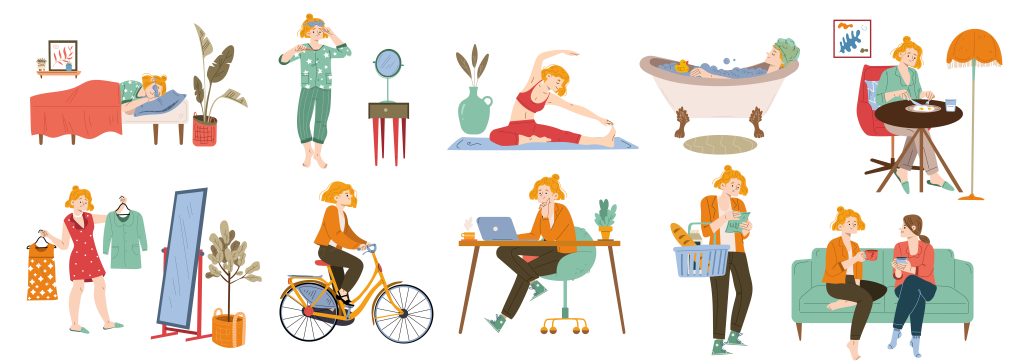🏃Arabic Level 2, Activity 05: “الأَفْعَال / Verbs” (Face-to-Face/Online)

Description:
In this activity, students will play a game as teams to learn some of the most common present-tense verbs to use in their daily life.
Semantic Topics:
يحفظ – يتذكر – يسافر – يستمع – يقرأ – يكتب – يأكل – أزمنة الأفعال, eating, writing, reading, traveling
Grammatical Structures:
Verb tences, present tense, الجملة الفعلية ,الجملة الاسمية
Products: Familiarize the most common present tense verbs used in daily life.
Practices: Describing and explaining present tense verbs by playing a game.
Perspectives: Interacting with a partner/team to identify verbs and answer questions related to one’s daily life.
- Standard 1.1: Students engage in conversations or correspondence in Arabic to provide and obtain information, express feelings and emotions, and exchange opinions.
- Standard 1.2: Students understand and interpret spoken and written Arabic on a variety of topics.
- Standard 2.1: Students demonstrate an understanding of the relationship between the practices and perspectives of the cultures of the Arab world.
- Standard 4.2: Students demonstrate an understanding of the concept of culture through comparisons between the cultures of the Arab world and their own
Idaho Content Standards for World Languages:
- COMM 1.1: Interact and negotiate meaning (spoken, signed, written conversation) to share information, reactions, feelings, and opinions
- COMM 2.1: Understand, interpret, and analyze what is heard, read, or viewed on a variety of topics.
- CLTR 1.1: Analyze the cultural practices/patterns of behavior accepted as the societal norm in the target culture.
- CLTR 1.2: Explain the relationship between cultural practices/behaviors and the perspectives that represent the target culture’s view of the world.
NCSSFL-ACTFL Can-Do Statements:
- I can describe/explain verb words to others.
- I can use he, she, and I with verb words.
- I can interact with a partner/team to identify words or answer questions.
Materials Needed:
- Google Slide Presentation
- Paper and pen
Warm-Up
For the warm-up, students will practice how they say verbs with simple different subject pronouns. For example: I, she, he
من أجل الإحماء ، سيتدرب الطلاب على كيفية نطق الأفعال بضمائر موضوعات مختلفة بسيطة. على سبيل المثال: أنا ، هي ، هو
- You will have a couple of slides that have the verb (مصدر الفعل) and three pictures. The first describes the pronoun ‘I’, the second describes the pronoun ‘he’, and the last describes the pronoun ‘she’.
سيكون لديك شريحتان بهما الفعل (مصدر الفعل) وثلاث صور. يصف أحدهم الضمائر I ، ويصف الثاني الضمائر ، ويصف الأخير الضمائر هي.. - Using the slides, students will say the verb in present tense. For example: الأكل (هي تأكل، هو يأكل، أنا أأكل)
باستخدام الشرائح ، سيقول الطلاب الفعل في زمن المضارع.على سبيل المثال: الأكل (هي تأكل ، هو يأكل ، أنا أأكل)
Main Activity
- You will put students into two break-out rooms. Give them 3-5 minutes to come up with 5 verbs in Arabic.
سوف تضع الطلاب في غرفتين منفصلتين. امنحهم 3-5 دقائق للتوصل إلى 5 أفعال باللغة العربية. - Then come back as a class. From each team, one member will volunteer to act on the verb.
ثم عد ، من كل فريق يتطوع عضو واحد لتمثيل الفعل. - The other team will try to guess the verb and say it aloud.
They have about 1 minute to figure out the verb word.سيحاول الفريق الآخر تخمين الفعل وقوله بصوت عالٍ.لديهم حوالي 1 دقيقة لمعرفة كلمة الفعل. - After that, it’s the second team’s turn. They will repeat the same steps. بعد ذلك ، جاء دور الفريق الثاني. سوف يكررون نفس الخطوات.
- The lab assistant will track the time and team points for the students. The team who has more points is the winner.
If they end up with equal points, you can ask the teams to use verbs in one full sentence and write it on the whiteboard. The fastest team to do this is the winner.
سيحسب المساعد الوقت للطلاب ، ويكتب كل نقطة من نقاط الفريق. الفريق الذي لديه المزيد من النقاط هو الفائز.
إذا انتهى بهم الأمر بنقاط متساوية ، يمكنك أن تطلب من كلا الفريقين استخدام الأفعال في جملة واحدة كاملة وكتابتها على السبورة البيضاء. الفريق الأسرع يفعل ذلك ؛ هم الفائزون.
Wrap-Up
- Ask the student, can you come up with either: جملة فعلية أو جملة اسمية؟
- Give them an example:جملة فعلية : أكلت اللحم جملة اسمية : الجو بارد
End of Activity
- Read Can-Do statements once more and have students evaluate
their confidence.
(Use thumbs up/thumbs down or download our student cards.) - Encourage students to be honest in their self-evaluation.
- Pay attention, and try to use feedback for future activities!
NCSSFL-ACTFL Can-Do Statements:
- I can describe/explain verb words to others.
- I can use he, she, and I with verb words.
- I can interact with a partner/team to identify words or answer questions.

